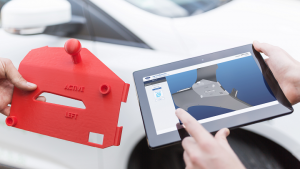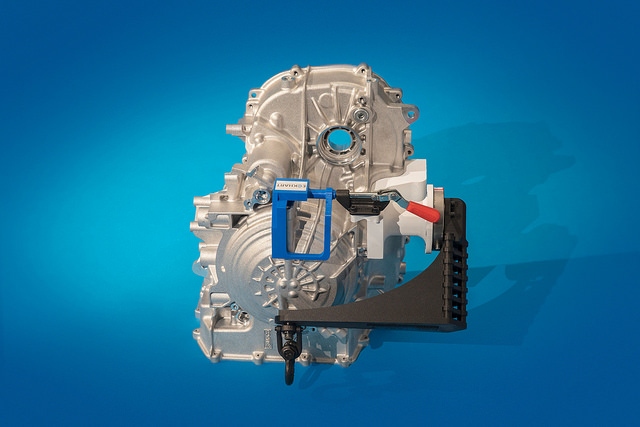Popular automotive manufacturer Ford, which has long used 3D printing to fabricate assembly tools and was recently recognized for its work with the technology, is now partnering up with award-winning software company trinckle in order to automate the design process for its 3D printed production tools. The two companies will present the joint project next week during formnext.
“The additive manufacturing itself is no longer the dominating cost factor limiting the scalability of the application. Up to 50% of the total costs per tool are caused by the manual design, which is the new bottleneck. For each new line and each special edition, these tools must be specifically designed to position the badges with exact accuracy,” explained Lars Bognar, an engineer with Ford Research & Advanced Engineering Europe. “This design task is not a trivial one, as the tools have to adapt precisely to the free-form surfaces of the car body sheet. It can easily last between two and four hours to create an appropriate AM-ready design. Time that is hard to spend for the designers, who are already working at full capacity. In the worst case, a short-term demand can result in a delay of assembly because the corresponding tools are not available. It was time for us to rethink the design process from scratch, and that’s when we came across the trinckle team.”
 Based in Berlin, trinckle, a 3D printing service and software company, specializes in product configuration and automated design. The company uses its cloud software paramate to create software applications, which can integrate the user into the process, for the automated design of 3D printed products across a wide range of industries, including automotive.
Based in Berlin, trinckle, a 3D printing service and software company, specializes in product configuration and automated design. The company uses its cloud software paramate to create software applications, which can integrate the user into the process, for the automated design of 3D printed products across a wide range of industries, including automotive.
Many automotive manufacturers use 3D printing to fabricate assembly aids and hand tools, like fixtures and jigs. There are many advantages, including lower weight and production costs and faster availability. Ford, which currently has over 50 different 3D printed tools in serial production, is working with trinckle to further scale the applications of the technology.
 Bognar and his fellow engineer Raphael Koch didn’t want to settle for just saving a little money, and decided to, as trinckle put it, look “at the AM application as a whole.” They decided to use a hand tool called a labeling jig, which places model badges on the body of a vehicle, as an example.
Bognar and his fellow engineer Raphael Koch didn’t want to settle for just saving a little money, and decided to, as trinckle put it, look “at the AM application as a whole.” They decided to use a hand tool called a labeling jig, which places model badges on the body of a vehicle, as an example.
trinckle developed an internal application for Ford so it could efficiently generate these tools by creating new jig designs in just minutes. Employees can upload the car body’s model data, and the necessary badges, through an intuitive user interface. Then, with just a click of the mouse, standard elements like edge guides, handles, magnet mounts for fixation, and text fields can be easily added. Software algorithms generate the tool’s geometry so it fits the contour of the car body.
“The trinckle software application does not only dramatically reduce manual design times and costs, but also streamlines the entire process,” said Koch. “We enable our employees on the shop floor to take over more responsibility and relieve our designers at the same time. The latter can focus on their core activities again.”
Now, instead of lasting two to four hours, the design process only takes 10 minutes, thanks to the straightforward handling provided by paramate. Because AM-compliant design expertise is not necessary, assembly line employees can easily design 3D printable tools on their own and independently carry out tool optimization iterations.
 Using automation to design 3D printable labeling jigs is only the first step in the right direction for Bognar and Koch, and in the near future, other additive tools will likely undergo similar automation.
Using automation to design 3D printable labeling jigs is only the first step in the right direction for Bognar and Koch, and in the near future, other additive tools will likely undergo similar automation.
To learn more about this work with Ford, and its other business applications, visit trinckle at booth C07 in Hall 3.0 at formnext in Frankfurt next week. Bognar and Dr. Ole Bröker, the Head of Business Development at trinckle, will also be presenting the joint project at the TCT Conference during the show.
Discuss this story and other 3D printing topics at 3DPrintBoard.com or share your thoughts in the Facebook comments below.
Subscribe to Our Email Newsletter
Stay up-to-date on all the latest news from the 3D printing industry and receive information and offers from third party vendors.
Print Services
Upload your 3D Models and get them printed quickly and efficiently.
You May Also Like
Heating Up: 3D Systems’ Scott Green Discusses 3D Printing’s Potential in the Data Center Industry
The relentless rise of NVIDIA, the steadily increasing pledges of major private and public investments in national infrastructure projects around the world, and the general cultural obsession with AI have...
3DPOD 260: John Hart on VulcanForms, MIT, Desktop Metal and More
John Hart is a Professor at MIT; he´s also the director of the Laboratory for Manufacturing and Productivity as well as the director of the Center for Advanced Production Technologies....
Etsy Design Rule Change Reduces Selection of 3D Printed Goods
Online marketplace Etsy has implemented a rule change requiring all 3D printed goods on the site to be original designs. The update to the site’s Creativity Standards states, ¨Items produced using...
E-Beam OEM Wayland Additive Partners with USC Racing to 3D Print Titanium Exhaust Collector
Every year, standards organization SAE International holds a competition called Formula SAE, in which students from both undergraduate and graduate programs design, build, and race small formula-style race cars. For...



































